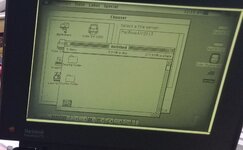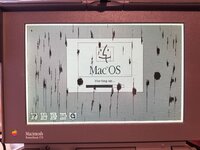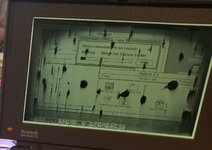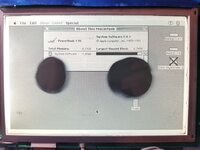3lectr1cPPC
Well-known member
@bwinkel67 on the TinkerDifferent forums proposed a new possible cause behind the infamous Tunnel Vision issue on monochrome and grayscale Active-Matrix LCDs on our precious PowerBooks! I offered to crosspost here to get more attention on it, and to hopefully get some people to test this new proposed fix out!
If you've been keeping up with the 8 page long tunnel vision thread here, you'll know that youtuber TheBasement (@Johanncerecke on these forums) did a video trying out the baking method on a 170 LCD with some success. Prior to this, he had tested another claimed fix of bending some tabs on the display in further, which unsurprisingly did nothing, proving this fix doesn't work.
Or does it?
First off, I'll copy in what @bwinkel67 said on the TD thread:
So, a couple of questions:
1. Has anyone actually proven that moisture is the cause, or has it always just been assumed due to the symptoms present?
2. Can anyone here with a tunnel vision-affected display try this new idea out?
3. This has only ever been proposed for a 170 LCD, do the LCDs used in the PB 180, Active-Matrix Duos, and the 540 also have these tabs?
I'd try it out on my own 170, but my LCD actually doesn't have the issue, so I can't.
That's all I've got, let me know what you can find!
If you've been keeping up with the 8 page long tunnel vision thread here, you'll know that youtuber TheBasement (@Johanncerecke on these forums) did a video trying out the baking method on a 170 LCD with some success. Prior to this, he had tested another claimed fix of bending some tabs on the display in further, which unsurprisingly did nothing, proving this fix doesn't work.
Or does it?
First off, I'll copy in what @bwinkel67 said on the TD thread:
For more context on this, here's the link to the thread itself: https://tinkerdifferent.com/threads/tunnel-vision-on-pb170.778/page-2#post-9513So I had an idea. I know that Johann did a video on his YouTube channel, The Basement, where he a) disproved the quick fix method of tightening the tabs, and b) baked the LCD with some success. The quick fix, I believe, came from another YouTuber in an under 5 minute video where he claimed that you could tighten the tabs and that would solve it (he also had a second method of reprogramming the logic chips which seems a bit questionable...dunno).
In any case, that got me thinking about the entire problem. Is it actually a moisture issue or is it just that the layers are coming apart due to failed glue after so many years? If so, then tab-tightening technique could work and when baking, perhaps it is the glue being re-flowed and not the moisture being driven out?! The temperatures listed are in the range of some glues softening, and if the layers are adhered together could that be what fixes it? Leaving it in longer allows the glue to soften more evenly perhaps. What I've seen from some finished pics/videos is that it returns more slightly and not as evenly as before (at least one video where a guy tried this with a different machine).
So if it is an adhesion problem then the technique of tightening the tabs could work as it is pushing the elastomeric strips to the circuit board which pushes back and perhaps presses the panel into the metal bracket forcing the layers to stay together when the panel warms up. Elastomeric strips do have some give (I'm assuming the LCD panel is using elastomeric strips since I haven't taken the panel completely apart). So I gave it a shot the other day and not only further bent the tabs inwards but also tried to get a pair of pliers to hold them firmly and and push the tabs towards the circuit board with a little torque. The screen still darkened but it seemed to have taken much longer and didn't seem to get as bad. Will do more experiments with it in the future. I'm thinking that instead of pliers perhaps a small hammer and pushing the board into the panel with a firm grip and then gently tapping the tabs might yield a tighter result...will see. Not too tight as I don't want to damage the elastomeric strips, which seem (on other devices) to be made of some type of silicon.
In any case, what do people think? Could it be an adhesion problem or has anyone tested specifically for moisture. I know some have said silica and vacuum helps, but then again, vacuum could also press the panel tightly together, re-adhering it for a bit. The fact that someone else said storing the LCD with a ton of silica packets (what I was trying) for half a year in a sealed bag had absolutely no impact just got me thinking, since that ought to drive out some moisture at the edges at least. I guess vacuum sealing it is supposed to squeeze the moisture out...trying to wrap my mind around if that makes sense. Btw, the guy who created the TRS-80 LCD's also tried baking them with no success.
So, a couple of questions:
1. Has anyone actually proven that moisture is the cause, or has it always just been assumed due to the symptoms present?
2. Can anyone here with a tunnel vision-affected display try this new idea out?
3. This has only ever been proposed for a 170 LCD, do the LCDs used in the PB 180, Active-Matrix Duos, and the 540 also have these tabs?
I'd try it out on my own 170, but my LCD actually doesn't have the issue, so I can't.
That's all I've got, let me know what you can find!






